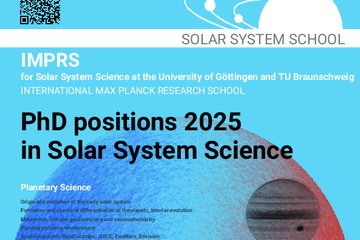All genres
121.
Talk
The size distribution of dust from comet 67P/Churyumov-Gerasimenko. EPSC Conference, Riga, Latvia (2017)
122.
Talk
Gibt es den 9. Planeten im Kuiper-Gürtel? Wissenschaft für jedermann, Deutsches Museum, München (2017)
123.
Talk
Rosetta - Die ESA Mission zum Ursprung des Sonnensystems. The Lions Club, Bad Herzberg, Germany (2017)
124.
Talk
Gibt es einen neunten Planeten im Kuiper-Gürtel? Vorträge am Forschungszentrum, Jülich, Germany (2017)
125.
Talk
Philae lander mission and science overview. 1st British Planetary Science Congress, Glasgow, Scotland (2017)
126.
Talk
Application of light scattering analysis Experiences in the imaging, spectroscopy and polarimetry domain. SAEMPL WS-S2P workshop , Tuusula, Finland (2017)
127.
Talk
Philae Lander Mission and Science Overview. Cometary science after Rosetta - The Royal Astronomical Society Discussion Meeting, London, U.K. (2016)
128.
Talk
Astronomy and astrophysics in the MPG from the 1980s to the present - Round Table. Opening New Windows on the Cosmos: Astrophysics and astronomy in the History of the Max Planck Society, Berlin, Germany (2016)
129.
Talk
Rosetta - From Launch Pad to the Comet. Astronomy for Non-Astronomers, Garching, Germany (2016)
130.
Talk
Cometary and Planetary Science with Rosetta. Munich Joint Astronomy Colloquium, Garching, Germany (2016)
131.
Talk
Die Rosetta Mission zu Komet 67P. Vagabunden im Weltraum - Rothenfelser Sternstunden, Burg Rothenfels, Germany (2016)
132.
Talk
Was Sie schon immer über Kometen wissen wollten, sich aber nie zu fragen trauten. Vagabunden im Weltraum - Rothenfelser Sternstunden, Burg Rothenfels, Germany (2016)
133.
Talk
Kuiper-Belt - Der asteroidengürtel am Rande des Planetensystems. Vagabunden im Weltraum - Rothenfelser Sternstunden, Burg Rothenfels, Germany (2016)
134.
Talk
Kometen und das frühe Sonnensystem. Kometenfieber, Göttingen, Germany (2016)
135.
Talk
Philae Achievements:Landing on a Comet - The Science View. Philae - From Dreams to Achievements - an International Conference, Budapest, Hungary (2016)
136.
Talk
67P Coma Structures (and a Bit more). Workshop on ground-based observations of 67P/Churyumov-Gerasimenko, Seggau/Graz, Austria (2016)
137.
Talk
Rosetta, die Weltraummission der ESA - Zweiter Teil. ahrestreffen der Internationalen Amateursternwarte e.V., Bad Soden - Salmünster, Germany (2016)
138.
Talk
Rosetta - ESA's Mission zum Ursprung des Planetensystems. Maristen-Gymnasium, Sternenfreunde Furth, Furth-Landshut, Germany (2016)
139.
Talk
Rosetta - ESA's Mission zum Ursprung des Planetensystems. Bürgerhaus, Sternwarte Neumarkt, Neumarkt in der Oberpfalz, Germany (2016)
140.
Talk
Planetary science with Rosetta at comet 67P/Churyumov-Gerasimenko. Physikalisches Kolloquium der Friedrich-Alexander Universität, Erlangen, Germany (2016)











